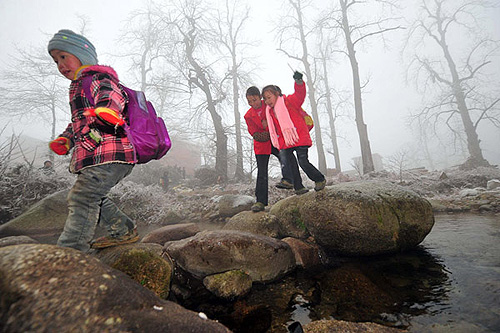|
 |
|
Children cross a river on their way home after school in the village of Dayuan in Quanzhou County, South China's Guangxi Zhuang Autonomous Region on January 10, 2011 (XINHUA) |
On the evening of January 10, Zhu Chaohua, deputy head of the Education Department of Guangdong Province, held an emergency meeting to collect information about the situation that elementary and secondary schools faced after a brutal cold wave hit the region. South China was rocked by a second round of frigid weather on January 9 and 10; the cities of Shaoguan and Qingyuan in northern Guangdong were hit the hardest.
More than 15,000 students of the province had already been affected by the first cold snap, which resulted in class suspensions in schools across the province. The second wave of cold weather prevented many of these students from resuming their normal class schedule. Luckily, local educational officials and other governmental bodies had already started to put emergency procedures into action.
The freezing weather had already affected many people in Guangdong since its arrival on January 3. Schools in northern Guangdong saw their water pipes freeze and crack; teachers and students in these schools had no drinking water for several days. The Shaoguan Municipal Government quickly gave the city's schools permission to suspend their classes until the problem could be fixed.
The Kaifeng Primary School, located in a mountainous area near the city of Lechang in Guangdong Province, is a small and simple school. On Monday, January 10, the school's bells tolled, but not a single student was around to hear them. Lei Fengrong, the school's principal, worried about the effect the weather might ultimately have on the students' studies.
Final exams are scheduled to be given on January 18, and the recent class suspensions have already dealt a blow to the students. However, Lei has been working hard to organize the school's teachers and send them to the students' homes to give make-up lessons.
Other schools in the area have struggled to stay open and keep classes going as scheduled. Shaoguan's Daqiao Center Middle School did not suspend classes; instead, government officials and teachers took measures to keep the students warm. Hot soup and tea were distributed and students from poorer families received extra blankets.
Guangdong educationalofficials will continue to assist students with its rescue team to help snowbound students to resume classes as soon as possible. The team will alsoprovideheaters for those students who are still attending class during the cold snap.
(Source: People's Daily, translated by ZHONG MING)
| 